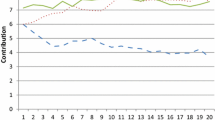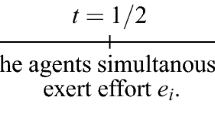Abstract
Most political and economic theorists point to moral hazard in teams as the main obstacle to lobbies’ collective action. In this paper, we address this important issue with a coalition-formation game. In the process of doing so, we characterize equilibrium lobby structures both in the absence and in the presence of moral hazard. Three notable results emerge from such an exercise: (1) an equilibrium lobby structure exists under both specifications of the model, (2) moral hazard in teams may raise large groups’ equilibrium lobby size, and (3) it may also raise the level of collective action of large groups with low organizational costs.
Similar content being viewed by others
References
Agrawal A, Goyal S (2001) Group size and collective action. Third-party monitoring in common-pool resources. Comp Polit Stud 34: 63–93
Baik KH, Lee S (2001) Strategic groups and rent dissipation. Econ Inq 39: 672–684
Baik KH, Shogren JF (1995) Competitive-share group formation in rent seeking contests. Public Choice 83: 113–126
Bloch F, Sánchez-Pagés S, Soubeyran R (2006) When does universal peace prevail? Secession and group formation in conflict. Econ Gov 7: 3–29
Carraro C, Siniscalco D (1997) Strategies for the international protection of the environment. J Public Econ 52: 309–328
Costain AN (1980) The struggle for a national women’s lobby: organizing diffuse interest. West Polit Q 33: 476–491
d’Aspremont CA, Jacquemin A, Gabszewicz JJ, Weymark J (1983) On the stability of collusive price leadership. Can J Econ 16: 17–25
Duggan J (2001) Non-cooperative games among groups. Wallis Institute of Political Economy, WP#21
Espinosa MP, Macho-Stadler I (2003) Endogenous formation of competing partnerships with moral hazard. Games Econ Behav 44: 172–183
Esteban J, Ray D (2001) Collective action and the group size paradox. Am Polit Sci Rev 95: 663–672
Felli L, Merlo A (2006) Endogenous lobbying. J Eur Econ Assoc 4: 180–215
Grossman GM, Helpman E (2001) Special interest politics. MIT Press, Cambridge
Gupta DK, Hofstetter CR, Buss TF (1997) Group utility in the micro motivation of colletive action: the case of membership in the AARP. J Econ Behav Organ 32: 301–320
Hojnacki M, Kimball DC (2001) PAC contributions and lobbying contacts in congressional committees. Polit Res Q 54: 161–180
Holmström B (1982) Moral hazard in teams. Bell J Econ 13: 324–340
Le Breton M, Salanie F (2003) Lobbying under political uncertainty. J Public Econ 87: 2589–2610
Martimort D (2004) Delegated common agency under moral hazard and the formation of interest groups. University of Toulouse, Mimeo
Masters MF, Delaney JT (1987) Union political activities: a review of the empirical literature. Ind Labor Relat Rev 40: 336–353
Mitra D (1999) Endogenous lobby formation and endogenous protection: a long-run model of trade policy determination. Am Econ Rev 89: 1116–1134
Mueller D (2003) Public choice III. Cambridge University Press, Cambridge
Murdoch JC, Sandler T, Vijverberg WPM (2003) The participation decision versus the level of participation in an environmental treaty: a spatial probit analysis. J Public Econ 87: 337–362
Ok EA (2007) Real analysis with economic applications. Princeton University Press, USA
Olson M (1965) The logic of collective action. Harvard University Press, Cambridge
Ostrom E (1998) A behavioral approach to the rational choice theory of collective action. Am Polit Sci Rev 92: 1–22
Pecorino P (1998) Is there a free-rider problem in lobbying? Endogenous tariffs, trigger strategies, and the number of firms. Am Econ Rev 88: 652–660
Pecorino P (2001) Can by-product lobbying firms compete. J Public Econ 82: 377–397
Petrakis E, Xepapadeas A (1996) Environmental consciousness and moral hazard in international aggreements to protect the environment. J Public Econ 60: 95–110
Saijo T, Yamato T (1999) A voluntary participation game with a non-excludable public good. J Econ Theory 84: 227–242
Sandler T, Hartley K (2001) Economics of alliances: the lessons for collective action. J Econ Lit XXXIX: 869–896
Sánchez-Pagés S (2007) Endogenous coalition formation in contests. Rev Econ Des 11: 139–163
Schneider F, Pommerehne WW (1981) Free riding and collective action: an experiment in public microeconomics. Q J Econ 96: 689–704
Tullock G (1980) Efficient rent-seeking. In: Buchanan JM, Tollison RD, Tullock G(eds) Toward a theory of the rent-seeking society. Texas A&M University Press, College Station
Author information
Authors and Affiliations
Corresponding author
Additional information
I wish to express my appreciation to Helmuth Cremer, Philippe De Donder, Kai A. Konrad, Michel Le Breton, Daniel Seidmann, Shlomo Weber, an associate editor of this journal and a referee for valuable comments and suggestions. I am also grateful to Paul Belleflamme, Francis Bloch, Robert Dur, Joan Esteban, Debraj Ray, and the audience at the CESifo Area Conference on Public Sector Economics 2006 and at the 15th Aix-Marseille SSIEIO for helpful discussions.
Rights and permissions
About this article
Cite this article
Anesi, V. Moral hazard and free riding in collective action. Soc Choice Welf 32, 197–219 (2009). https://doi.org/10.1007/s00355-008-0318-8
Received:
Accepted:
Published:
Issue Date:
DOI: https://doi.org/10.1007/s00355-008-0318-8




